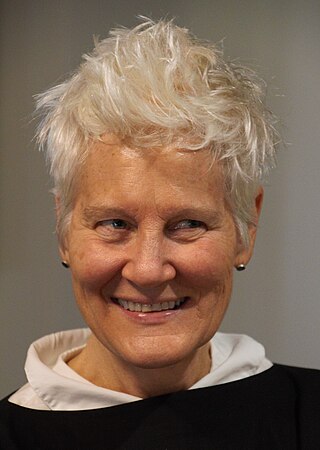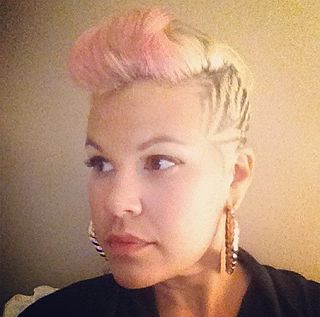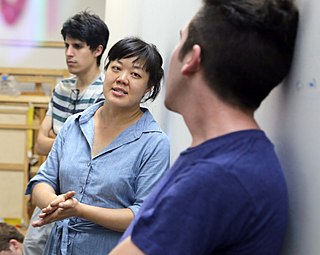Related Research Articles

Michael Kelley was an American artist widely considered one of the most influential artists of our time. His work involved found objects, textile banners, drawings, assemblage, collage, performance, photography, sound and video. He also worked on curatorial projects; collaborated with many other artists and musicians; and left a formidable body of critical and creative writing. He often worked collaboratively and had produced projects with artists Paul McCarthy, Tony Oursler, and John Miller. Writing in The New York Times, in 2012, Holland Cotter described the artist as "one of the most influential American artists of the past quarter century and a pungent commentator on American class, popular culture and youthful rebellion."

Ann Hamilton is an American visual artist who emerged in the early 1980s known for her large-scale multimedia installations. After receiving her BFA in textile design from the University of Kansas in 1979, she lived in Banff, Alberta, and Montreal, Quebec, Canada before deciding to pursue an MFA in sculpture at Yale in 1983. From 1985 to 1991, she taught on the faculty of the University of California at Santa Barbara. Since 2001, Hamilton has served on the faculty of the Department of Art at the Ohio State University. She was appointed a Distinguished University Professor in 2011.

Janet Echelman is an American sculptor and fiber artist. Her sculptures have been displayed as public art, often as site-specific installations.

The Penny W. Stamps School of Art and Design is the school of art and design of the University of Michigan located in Ann Arbor, Michigan. The school offers graduate and undergraduate degrees in art and design.

María Elena González is a Cuban-American sculptor based in Brooklyn and the Bay Area. She is known for objects, installations and public art that interweave post-minimalist form, conceptual art and concern for materials and craft. Her early work explored themes of memory, family, identity, loss and dislocation through formal, architectural and mapping modes that address site, place and social circumstances; her later work makes connections between nature and art, engaging a broad range of media and sensory experience. In 2020, artist and scholar Ellen Levy wrote "González's art re-invents nature as culture" through an "exquisite attunement" that uncovers formal and thematic analogies between both realms and synesthetic connections between visual and aural senses.
Penny Stamps Distinguished Speaker Series is a lecture series established by the University of Michigan School of Art & Design. With the support of Art and Design alumna Penny W. Stamps, the Penny Stamps Series presents visionary leaders who use their creative practice effectively. It celebrates those who transcend tradition and are progressive and influential with their work. Speakers are a range of emerging and established artists and designers from a broad spectrum of media, including painting, photography, architecture, sculpture and more.

Heather T. Hart is an American visual artist who works in a variety of media including interactive and participatory Installation art, drawing, collage, and painting. She is a co-founder of the Black Lunch Table Project, which includes a Wikipedia initiative focused on addressing diversity representation in the arts on Wikipedia.
Mequitta Ahuja is a contemporary American feminist painter of African American and South Asian descent who lives in Baltimore, Maryland. Ahuja creates works of self-portraiture that combine themes of myth and legend with personal identity.

Marina G. Zurkow is an American visual artist based in New York City who works with media technology, animation and video. Some of the less traditional mediums are known to be dinners, life science and bio materials. Her subject matter includes individual narratives, environmental concerns, and reflections on the relation between species, or between humans, animals, plants and the weather. Her artworks have been seen in solo exhibitions at DiverseWorks in Houston Texas and at FACT in Liverpool. Zurkow is the recipient of a Creative Capital grant and has had fellowships from the Guggenheim and the Rockefeller Foundation.
Cassils is a visual and performance artist, body builder, and personal trainer from Montreal, Quebec, Canada now based in Los Angeles, California, United States. Their work uses the body in a sculptural fashion, integrating feminism, body art, and gay male aesthetics. Cassils is the recipient of a Guggenheim Fellowship, a Creative Capital Grant, a United States Artists Fellowship, a California Community Foundation Visual Artist Fellowship (2012), several Canada Council for the Arts grants, and the Rema Hort Mann Foundation Visual Arts Fellowship. Cassils is gender non-conforming, transmasculine, and goes by singular they pronouns.
Julia Christensen is a multidisciplinary artist and writer based in Oberlin, Ohio. She is Associate Professor of Integrated Media and Chair of the Studio Art Department at Oberlin College.
Maureen Connor is an American artist who creates installations and videos dealing with human resources and social justice. She is known internationally for her work from the 1980s to the present, which focuses on gender and its modes of representation.

Deborah Stratman is a Chicago-based artist and filmmaker who explores landscapes and systems. Her body of work spans multiple media, including public sculpture, photography, drawing and audio.

Steffani Jemison is an American artist, writer, and educator. Her videos and multimedia projects explore the relationship between Black embodiment, sound cultures, and vernacular practices to modernism and conceptual art. Her work has been shown at the Museum of Modern Art, Brooklyn Museum, Guggenheim Museum, Whitney Museum, Stedelijk Museum Amsterdam, and other U.S. and international venues. She is based in Brooklyn, New York and is represented by Greene Naftali, New York and Annet Gelink, Amsterdam.
Joan Truckenbrod is an American artist. She is known for her work in digital art, and is credited as being one of the earliest pioneers of digital art in the 1960s. She uses sculptural forms in video to explore "the simultaneous experience of multiple realities that is evoked through ritual." An essential aspect of her artwork is "making things by hand, integrating hand construction with the electronic imagery of video".

Peter Burr is an American digital and new media artist. He specializes in animation and installation. He was also a touring member of the collective MOBILIVRE-BOOKMOBILE; and founded the video production company, Cartune Xprez. He is based in Brooklyn, New York.

Ja'Tovia Gary is an American artist and filmmaker based in Brooklyn, New York. Her work is held in the permanent collections at the Whitney Museum, Studio Museum of Harlem, and others. She is best known for her documentary film The Giverny Document (2019), which received awards including the Moving Ahead Award at the Locarno Film Festival, the Juror Award at the Ann Arbor Film Festival, Best Experimental Film at the Blackstar Film Festival, and the Douglas Edwards Experimental Film Award from the Los Angeles Film Critics Association.

Jen Liu is an American visual artist. She works with video, performance, and painting and creates pieces about labor, economy and national identity. She was awarded a Guggenheim and a Creative Capital award.
Patricia Villalobos Echeverría (1965) is an American-born Nicaraguan visual artist and educator of Salvadoran descent whose work spans printmaking, installation, video, sculpture, photography, and socially-engaged art. Her art is held in the permanent collections of a number of public institutions.
Guadalupe Maravilla, formerly known as Irvin Morazan, is a transdisciplinary visual artist, choreographer, and healer. At the age of eight, Maravilla was part of the first wave of unaccompanied, undocumented children to arrive at the United States border in the 1980s as a result of the Salvadoran Civil War. In 2016, Maravilla became a U.S. citizen and adopted the name Guadalupe Maravilla in solidarity with his undocumented father, who uses Maravilla as his last name. As an acknowledgment to his past, Maravilla grounds his practice in the historical and contemporary contexts belonging to undocumented communities and the cancer community. Maravilla's studio is located in Brooklyn, New York.
References
- ↑ "Heidi Kumao | Penny W. Stamps School of Art & Design at the University of Michigan". stamps.umich.edu. Retrieved 2016-03-13.
- ↑ McGovern, Judy. "U-M's Laura Kasischke and Heidi Kumao win Guggenheim Fellowships". Michigan Live. Retrieved 4 March 2016.
- ↑ "Kumao, Heidi". The Art Institute of Chicago. Art Institute Chicago. Retrieved 6 March 2016.
- 1 2 "Projects". Creative Capital.
- ↑ Hirsch, Robert (2014). Exploring Color Photography: From Film to Pixels. CRC Press. p. 85. ISBN 9781317911142.
- ↑ Licata, Elizabeth (December 1994). "HALLWALLS CONTEMPORARY ART CENTER". Artforum International. 33 (4).
- ↑ Wosk, Julie (28 July 2015). My Fair Ladies: Female Robots, Androids, and Other Artificial Eves. Rutgers University Press. ISBN 9780813575209.
- ↑ Chase, Alisia. "Surviving Confinement: Video Sculpture by Heidi Kumao" (PDF). Afterimage. 42 (3): 36. doi:10.1525/aft.2014.42.3.36 . Retrieved 4 March 2016.
- 1 2 3 4 "Heidi Kumao". Creative Capital. Retrieved 4 March 2016.